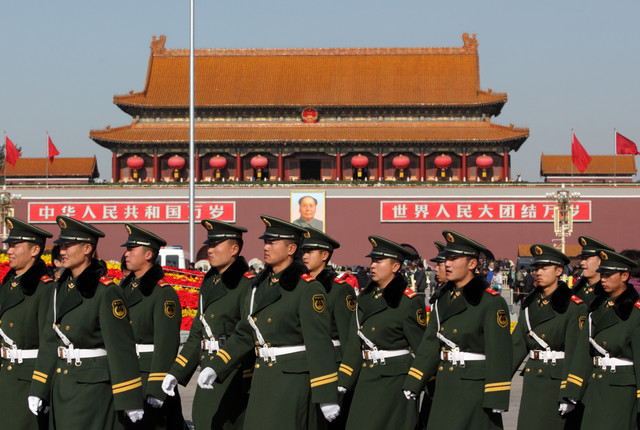Water Wars: Breaking Ice and Building Friendships
China Fires an ICBM; Competition in the Arctic; Bilateral and Multilateral Military Exercises in the Indo-Pacific
e304b8c6-62ac-4691-8f59-0c9a301d1565.jpg?sfvrsn=2eb0521f_8)
Published by The Lawfare Institute
in Cooperation With

As China and the United States continue military exercises with partners in Southeast Asia, melting ice saw increased competition further north—in the Arctic. From under the blanket of U.S. and European sanctions preventing Russia from acquiring icebreakers, Moscow leaned on its risky “shadow fleet” of unregistered vessels this summer to channel an unprecedented amount of oil through the Arctic Ocean.
Meanwhile, the United States and China continue in their race to break ice and exert power in the Arctic. China sent three of its research icebreakers to the Arctic this summer, after the United States’s single Arctic surface patrol suffered a fire in July. Canada, Finland, and the United States announced the Icebreaker Collaboration Effort on the sidelines of the NATO Summit in July.
Superpower Relations
Missiles and Mitigated Miscalculation
On Sept. 25, China fired an intercontinental ballistic missile (ICBM) carrying a dummy warhead from Hainan island and over Pacific waters. The launch, carried out by the People’s Liberation Army Rocket Force, was the first publicly announced ICBM test in 44 years. According to the Ministry of National Defense, the launch “was not directed at any specific country or target” but instead constituted a routine part of the Rocket Force’s annual exercises and was “in line with international law and international practice.”
Xinhua, China’s official news agency, further stated that China, which usually tests missiles within its borders, had notified “the relevant countries” about the launch. The United States corroborated this the day of the launch, with the Department of Defense praising Beijing for providing Washington with “some advanced notification of [the] ICBM test,” describing the notice as “a good thing” and “a step in the right direction” that may “prevent[] any misperception or miscalculation.” According to Sabrina Singh, a Pentagon spokeswoman, the United States had been pressing China for more regular notifications for such ICBM and space launches. Nevertheless, some analysts and commentators have described the test as demonstrating something else: the combat readiness of China’s Rocket Force and the country’s nuclear ambitions and capabilities. China maintains a policy of “no first use” of nuclear weapons. The missile test is thought to involve the DF-31AG, a nuclear-capable ICBM that can hide from U.S. satellites by “go[ing] off-road” and, if fired from one of China’s new silos, could strike anywhere in the continental United States.
The missile, which was launched during the ongoing United Nations General Assembly (UNGA) meeting in New York, eventually fell into international waters around French Polynesia, although China’s Ministry of National Defense did not specify the exact coordinates. Chinese newspapers published a map showing a target area in the center of the circle formed by the Solomon Islands, Nauru, the Gilbert Islands, Tuvalu, western Samoa, Fiji, and the New Hebrides. During his speech to the UNGA on Sept. 26, Fijian President Ratu Wiliame Katonivere called for the cessation of missile tests in the Pacific Ocean and for “respect for [the] region,” specifically denouncing China’s “unilateral” ICBM test. The French Polynesian media reported that the missile had landed near the French Pacific territory’s exclusive economic zone. After learning about the missile launch in the media, French Polyneasian President Moetai Brotherson sent a protest letter to the Chinese Embassy. However, France’s High Commissioner, Eric Spitz, said China had notified France about the test. Australian Treasurer Jim Chalmers also said that he broached the topic of the missile test in a meeting with his counterpart in Beijing. New Zealand Foreign Minister Winston Peters described the missile launch as concerning and reiterated that leaders in the region “have clearly articulated their expectation” of “a peaceful, stable, prosperous, and secure region.”
Sunken Nukes and Naval Readiness
On the same day as China’s ICBM launch, Pentagon officials revealed that China’s newest nuclear-power submarine had sunk in a shipyard near Wuhan in either late May or early June. China had tried to cover up the incident, and U.S. officials do not know whether the submarine was carrying nuclear fuel at the time of sinking, although nongovernment experts have indicated that it likely was. China had been starting to move the manufacturer of nuclear-powered attack submarines to the Wuchang Shipyard near Wuhan to diversify production. The submarine that sank was a Zhou-class vessel, the first of a new class of Chinese nuclear-powered subs. It featured a X-shaped stern designed to make it more maneuverable and was built by China State Shipbuilding Corp., a state-owned company. Neither the People’s Liberation Army nor local authorities have acknowledged the episode.
The news of the sub’s sinking comes just weeks after the release of the Navigation Plan for America’s Warfighting Navy 2024 by the U.S. chief of naval operations. The plan serves as strategic guidance for the U.S. Navy. According to Chief of Naval Operations Adm. Lisa Franchetti, the plan prioritizes increasing U.S. readiness “for potential conflict with [China] by 2027 while also enhancing the Navy’s long-term warfighting advantage.” Discussing the plan at an event with the Center for Strategic and International Studies, Franchetti described China as a “pacing challenge” and said that Beijing was on “a wartime footing.” The plan lays out seven core targets, including scaling robotic and autonomous systems in order to “integrate more platforms at speed.”
Republican Lawmakers Sound Alarm in Report on U.S.-China Research
On Sept. 23, the House Select Committee on the Chinese Communist Party and House Education and Workforce Committee released a report arguing that U.S.-China partnerships at universities have helped Beijing develop critical technology with potential military uses. The report, which concluded a year-long investigation, asserts that U.S.-funded researchers and universities contributed to China’s technological advancement and military modernization, including in areas such as hypersonic weapons, artificial intelligence, nuclear technology, and semiconductor technology. On account of its findings, it urged for stronger safeguards and enforcement.
The Republican-controlled U.S. House of Representatives approved a package of 25 China-related bills in September. The bills aim to reduce and counter China’s growing influence and power in fields such as biotech, drones, and electric vehicles. Advocacy groups have raised concerns about how the bills and surrounding rhetoric may negatively affect Asian Americans. The Chinese Embassy in Washington, D.C., labeled the legislation as “new McCarthyism.” According to Liu Pengyu, a spokesman at the embassy, the bills, if passed, “will cause serious interference to China-U.S. relations and mutually beneficial cooperation, and will inevitably damage the U.S.’s own interests, image and credibility.”
Arctic Competition
Arctic sea ice is usually at its lowest point during the (relative) warmth of September—and amid a warming climate this year’s ice levels were particularly low. The Arctic Ocean’s role in North Asian security was thus in focus in September as Russia and China took advantage of the narrow window of easier navigation.
Russia Sends Oil and Gas Through the Arctic in an Effort to Dodge Sanctions
In recent years, Russia, at times in cooperation with China, has attempted to build out its capacity to ship goods through the Arctic. However, wide-ranging Western sanctions have slowed the pace of Russia’s liquified natural gas (LNG) sales from its flagship Arctic LNG 2 project, built to supply LNG primarily to Asian markets. U.S. and European Union sanctions made it difficult for Russia to acquire the “icebreaker” vessels they needed to transport LNG from the development through the ice-covered Arctic waters.
But in September, Russia was able to transport its first shipment of LNG out of the Arctic through a potentially dangerous ploy—using a conventional LNG carrier not outfitted for hazardous icy conditions. The ship transferred its shipment to an LNG storage facility on Russia’s Kamchatka Peninsula in late September after a journey through the Arctic. The ship is part of Russia’s “shadow fleet”—aging, unregistered vessels used to avoid detection (and sanctions). Bloomberg News also reported on Sept. 26 that, as of about a month out from the end of the summer navigation season, Russia has transported a record amount of oil through the Arctic Ocean.
However, Russia continues to struggle to find buyers, so for now the LNG will sit in storage. In late September, India’s oil secretary told reporters that India would not buy gas from the Arctic LNG 2 facility. Moreover, Russian state-owned Rosatom, which operates Russia’s nuclear-powered icebreaker fleet, said that the Arctic route to Asia will close earlier than usual this season (around Oct. 15)—limiting the impact of Russia’s belated efforts to use the route to offload Arctic LNG 2’s production.
Separately, Russia is continuing to pursue an overland gas pipeline to China—which Russian President Vladimir Putin said after a meeting with Mongolian President Ukhnaagiin Khurelsukh in early September was “at the stage of expert appraisal and assessment.” And the first transit of a large container ship through the Arctic, traveling from St. Petersburg to Shanghai, finished in late September in just over three weeks—demonstrating the commercial value of conventional goods shipment through the northern route. Previous trips had only involved smaller box shipping vessels. The voyage took just over three weeks, about two weeks less than if it had transited the typical route through the Suez Canal.
China and United States Icebreaker Competition Continues
China sent three icebreakers to the Arctic this summer, the most significant set of Chinese missions to the Arctic yet—considered doubly significant given that the display of technical capabilities came after a fire on the United States’s single Arctic surface patrol forced the vessel to return to shore in July. The three Chinese ships are all research vessels. Aidan Powers-Riggs, an analyst at the Center for Strategic and International Studies, told U.S. Naval Institute News that the ships represented “a clear signal” about Beijing’s commitment to projecting power in the Arctic.
A late August Congressional Budget Office report, meanwhile, delivered bad news for U.S. Arctic efforts: The Coast Guard program upgrading its polar fleet by building a class of new heavy icebreakers, the Polary Security Cutter program, may end up $1.9 billion over budget (60 percent of the base budget) and continues to be behind schedule.
The Department of Defense’s updated 2024 Arctic Strategy, released in July, recognized the shifting Arctic geopolitics. The report argued that China’s three icebreakers in the Arctic “enable [China’s] dual civil-military research efforts” and recognized that the “growing cooperation” between China and Russia in the region has “the potential to alter the Arctic’s stability and threat picture.” And on the sidelines of the NATO meeting in July, the leaders of Canada, Finland, and the United States announced the Icebreaker Collaboration Effort, or ICE Pact. The group “commit[ed]” to collaborate in building “best-in-class” icebreakers.
In Search of Allies
China Holds Joint Drills With Thailand, Singapore
Late last month, China held its annual air force drill with Thailand in an effort to strengthen its defense relations in Southeast Asia. The 11-day exercise, known as Falcon 2024, began at the Royal Thai Air Force Base in Udon Thani province in northeastern Thailand, and it constituted the seventh training exercises between the two countries’ air forces. According to China’s national television broadcaster CCTV, the exercises covered cross-border support, joint air defense, force deployment, and deterrence and debriefing—using special forces, warplanes, and helicopters. CCTV also reportedly noted the exercises’ purpose of “beef[ing] up military cooperation and address[ing] shared security challenges.” One former People’s Liberation Army officer and military analyst noted that the exercises contained “all the elements needed for a small-scale war” and said that the newly added special forces and helicopter drills would “enable forces to reach key areas directly without the need for parachutes.” China also staged joint exercises with Cambodia and Laos earlier this year, and during Vietnamese President To Lam’s visit to Beijing in August, Xi Jinping reaffirmed his hope for greater security cooperation.
Yokie Rahmad Isjchwansyah, a research fellow at the Paramadina Graduate School of Diplomacy in Jakarta, believes that Bangkok’s involvement in the annual Falcon exercises reveals its more cautious position vis-a-vis the United States—particularly after the latter declined to sell F-35 stealth fighter jets to Thailand in 2023.
In early September, China conducted a five-day joint maritime exercise with Singapore—the third occurrence since its inception in 2015—to “promote practical exchanges and cooperation” between the two countries. The China-Singapore Exercise Maritime Cooperation took place at a military port in Zhanjiang in China’s southeast Guangdong province. It consisted of numerous offshore drills, including helicopter cross-deck landing, search and rescue, and gunner firing. An admiral in Singapore’s Ministry of Defence said the exercise exemplified “the strong and friendly defense relationship between Singapore and China” and that it has “consistently provided invaluable opportunities for our navies to learn from each other, build mutual trust and understanding, and forge friendships.”
Ian Storey, a senior fellow at the ISEAS-Yusof Ishak Institute, noted that “[o]n the whole ... China is still more comfortable with bilateral exercises rather than complex multilateral drills.” Isjchwansyah argued that its focus on bilateral exercises is due to China’s cautious approach to information sharing with partners. Many analysts have noted the indispensable role of defense cooperation drills and military exercises in China’s strategy in Southeast Asia, including Ni Lexiong, a Shanghai-based military analyst who said that “it is of vital importance for Beijing to make sure that even if it cannot be turned into an ally, ASEAN [the Association of Southeast Asian Nations] would at least remain neutral without taking Washington’s side.” Considering Beijing’s rapidly deteriorating ties with Manila, Carl Thayer, emeritus professor at the University of New South Wales in Australia, said that “China hopes the ‘nervous Nellies’ in ASEAN will put pressure on the Philippines to stand down in order to reduce tensions and the prospect of US intervention.”
Indonesia Hosts Multilateral Military Exercise
Earlier this month, Indonesia hosted a two-week joint military exercise involving more than 4,500 personnel and including military counterparts from the United States, Japan, Singapore, the United Kingdom, Australia, Canada, France, Brazil, Brunei, India, South Korea, New Zealand, and Thailand. The event, known as Super Garuda Shield, has been held since 2006 and included simulations such as land and air operations, combat search and rescue, and engineering and cargo delivery exercises. The drills took place in Sidoarjo in East Java province and notably included a joint exercise against cyber threats. One Indonesian military official said the exercise is a means “to build trust, as well as to strengthen bilateral and multilateral relations.” A U.S. Army commander taking part in the operation said that the partnership “enhances [their] ability to respond to crises in the region or to help one another in times of need” and that the “participation of over 23 nations” demonstrates a commitment to “enhancing readiness, improving warfighting skills, and fostering interoperability across the multinational spectrum.”
A study by the Lowy Institute shows that mainland states in Southeast Asia—such as Cambodia, Laos, Myanmar, and Vietnam—have favored military drills with China over the United States, whereas Thailand and ASEAN hold more drills with the United States.
Myanmar Seeks to Join BRICS
During a recent visit to Moscow, the information minister of Myanmar’s military junta announced the junta’s desire to join BRICS, an intergovernmental organization founded in 2006 by Brazil, Russia, India, and China (with South Africa joining in 2010) that now includes 10 member states. Other nations that have expressed an interest in joining include Cambodia, Indonesia, Laos, Malaysia, Thailand, Vietnam, and North Korea. According to Adam Simpson, a senior lecturer of international studies at the University of South Australia, the junta’s move reflects an effort to seek legitimacy. Joining BRICS would notably enable the junta to access funding from the organization’s New Development Bank.







